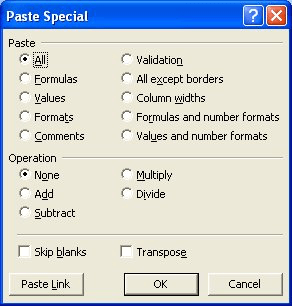Please Note: This article is written for users of the following Microsoft Excel versions: 97, 2000, 2002, and 2003. If you are using a later version (Excel 2007 or later), this tip may not work for you. For a version of this tip written specifically for later versions of Excel, click here: Transposing and Linking.
Written by Allen Wyatt (last updated March 21, 2020)
This tip applies to Excel 97, 2000, 2002, and 2003
Excel offers many different ways to paste information that you have copied. You can see these different methods when you choose the Paste Special option from the Edit menu. Two of the most popular pasting methods are transposing and linking.
Unfortunately, it seems that these two options are mutually exclusive. If you select the Transpose option, the Paste Link button is grayed out so you can no longer select it.
There are two ways you can get around this. One involves modifying the pasting process, and the other involves the use of a formula. The first method is as follows:

Figure 1. The Paste Special dialog box.

Figure 2. The Replace dialog box.
This may seem like a lot of steps, but it is not that bad in reality. Also, if you find yourself doing this procedure a lot, you can create a macro that does it for you.
If you would rather use the formula process, follow these steps:
At this point your information, linked from the original, appears in the selected range.
ExcelTips is your source for cost-effective Microsoft Excel training. This tip (2652) applies to Microsoft Excel 97, 2000, 2002, and 2003. You can find a version of this tip for the ribbon interface of Excel (Excel 2007 and later) here: Transposing and Linking.

Create Custom Apps with VBA! Discover how to extend the capabilities of Office 365 applications with VBA programming. Written in clear terms and understandable language, the book includes systematic tutorials and contains both intermediate and advanced content for experienced VB developers. Designed to be comprehensive, the book addresses not just one Office application, but the entire Office suite. Check out Mastering VBA for Microsoft Office 365 today!
Enter information into a cell, and Excel needs to figure out what type of information it is. Here's how Excel interprets ...
Discover MoreIf you need to look at different parts of the same worksheet at the same time, the answer is to create windows for your ...
Discover MoreWhen entering data in a worksheet, you may only want to add information to the cells in a particular range. You can ...
Discover MoreFREE SERVICE: Get tips like this every week in ExcelTips, a free productivity newsletter. Enter your address and click "Subscribe."
2022-12-06 06:07:22
Richard Mansell
Brilliant! Transposing lost the links and I couldn't edit the cells. Thanks!
2022-01-02 23:47:33
Masthan
Absolutely amazing, indeed the steps are very easy and given in a way to execute easily. Thanks a ton. Masthan
2021-06-29 01:10:49
this is amazing ! Thank you so much
2021-01-19 20:04:40
Bimo Notowidigdo
This is simply brilliant .... Thank you for sharing this wonderful tip. Has made my work a lot easier and saved me so much time.
2020-12-29 00:59:13
Clint Ward
I use the keyboard short cuts to paste special - values - transpose and then do it again (while the tranposed cells that have the pasted values in them are still highlighted) and the paste link button is no longer greyed out and the past link works. (Office 365 Enterprise though...)
2020-10-12 09:14:39
Giel Verbeeck
Thank you for this tip. I spent the most time on finding the £ symbol, ultimately not needed at all as most other symbold would do too.
2020-10-01 20:28:15
Augustin Hong
CLEVER! This is a great hack.
2020-08-13 08:04:42
Himalaya Parajuli
Thank you for making my work easy, Transpose and Link :)
2020-04-03 02:28:55
brian
awesome trick - you just saved me a bunch of time
Got a version of Excel that uses the menu interface (Excel 97, Excel 2000, Excel 2002, or Excel 2003)? This site is for you! If you use a later version of Excel, visit our ExcelTips site focusing on the ribbon interface.
FREE SERVICE: Get tips like this every week in ExcelTips, a free productivity newsletter. Enter your address and click "Subscribe."
Copyright © 2025 Sharon Parq Associates, Inc.
Comments